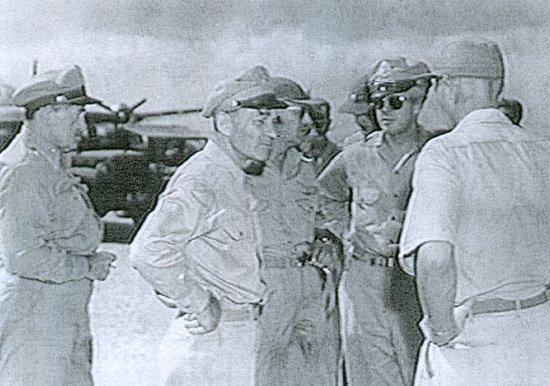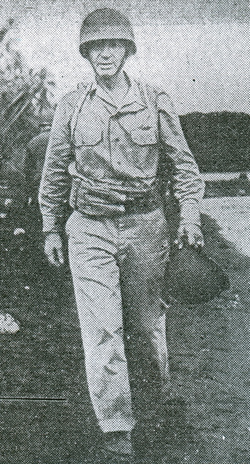|
Millard F. Harmon was born at San Francisco, CA, January 19, 1888. As such, he was one of the older pilots to sign the Tucson Register. He became, along with many other Register signers like Doolittle, Kirtland, Armstrong, Andrews, Arnold, Bertrandias, Eaker, and others, one of the prime movers and participants in air power in the early and mid-20th century.
He was a prolific visitor as both pilot and passenger to the Airfield, signing his name at least 19 times between 1928 and 1935. All his landings were in three primary military aircraft models: Boeing, de Havilland, and Douglas. He was based at Ft. Leavenworth, KS, Barksdale Field in Shreveport, LA, and at Riverside, CA, March Field during the period of the Register.
Interestingly, most of his landings were as part of multi-aircraft flights. For example, on Friday, March 30, 1928 he landed with four other pilots, Nathan Twining, Leo H. Dawson, James L. Grisham and Idwal Edwards. On Friday, November 9, 1928 he landed with Leonard D. Weddington, headed east to Lordsburg, NM (probably then to El Paso or San Antonio) from Riverside. They returned together from Lordsburg to Riverside on Wednesday, November 14, 1928. Likewise, his last landing on Wednesday, May 15, 1935, was as part of a three-plane flight of Boeing P-26 aircraft from Riverside to El Paso, TX, probably on their way to Barksdale. His fellow pilots were Carlton Bond and Oliver P. Gothlin.
He landed as a passenger twice, on Thursday, September 5, 1929 with pilot Barney Giles, and on Monday, February 13, 1933 with pilot H.M. Wittkop. In the latter landing he was with six fellow passengers in an unidentified Ford C-9 Trimotor transport.
His NASM biographical file (cited, left sidebar) is rich with news articles and biographical information, but sparse with early photographs. Following his graduation from the US Military Academy, June 12, 1912, he began his career as 2nd Lieutentant of Infantry, and was stationed successively in Minnesota, Kentucky, Texas and the Philippines. while with the 27th Infantry he was, in November, 1915, attached to the Aviation Section, Signal Corps, and assigned to flight training at San Diego, CA. He completed training on October 15, 1916 and was attached to the 1st Aero Squadron with the so-called Punitive Expedition into Mexico. He was rated Junior Military Aviator, June 16, 1917.
During WWI, he was assigned the inspection and laying out of landing fields, and various other staff assignments in France. Recalled to Washington, DC in May, 1918, he was assigned as Chief of the Flying Branch, Schools Section, Office of the Director of Military Aeronautics. On August 6, 1918, he was tasked with heavier-than-air training.
In a whirl of assignments and reassignments, in October, 1918, he was assigned to the command of the First Provisional Wing at Mineola, L.I., NY and served there until January, 1919, when he was ordered to Panama to assume command of the air forces to be placed in operation in the Canal Zone. He was commanding officer of France Field, Panama C.Z.
In April, 1921, he was assigned to duty in the Office of the Chief of Air Service, serving there until January, 1922, as a member of the Advisory Board and then in the Training and War Plans Division. In the fall of 1923, he went to the General Service Schools, Ft. Leavenworth, KS, and the Army War College. After graduation, he was assigned as commanding officer at Bolling Field, Washington, DC, and in September, 1925 as a member of the War Department General Staff. With the re-establishment of March Field, Riverside, CA as a Primary Flying School, he was, in April, 1927, assigned as Commandant thereof, and remained there until August, 1930, when he was placed on duty at Ft. Leavenworth, KS as Instructor at the Command and General Staff School.
In June, 1932, he was assigned to Barksdale Field, LA as commanding officer of the 20th Pursuit Group. By virtue of that assignment, he was promoted to Lt. Colonel. This history of the 20th broadens the scope of the role Harmon played in the group during his four-year tenure, October 1, 1932-October 6, 1936. Please note that there are internal contradictions on that site regarding dating of aircraft transitioning. For example, it gives October, 1934 for the switch from P-12s to P-26s, but elsewhere on the site that date is given as October, 1932.
We find Harmon at Tucson in this command role on Tuesday, February 21, 1933. He is alone flying an unidentified Boeing P-12-E. He identified his rank as Major, thus arriving at Tucson before he was promoted. He was eastbound from Riverside, CA, March Field to Barksdale. The purpose of his flight was noted in the remarks column of the Register simply as "Ferry". As of July 15, 1935, he had accumulated over 2,000 flight hours.
He continued to be promoted during the late 1930's/early 1940's (Lt. Col. to Colonel, 1936-38; Brigadier General 1940). As of June 23, 1941, he had accumulated 3,435 flight hours. He was promoted to Major General July 11, 1941.
It wasn't long before Maj. Gen. Millard Harmon was a commander of Army air forces in the South Pacific during WWII. He was assigned that role as part of the shake-up in management that took place after Pearl Harbor. The Army Times of December 27, 1941, gave the reason as, "... the Army and Navy were not on the alert when the Japanese attacked ..."
Millard Harmon, (C profile), Pacific Area, WWll
 |
M.F. Harmon, Pacific Theater, August 15, 1943
 |
Above, a photograph from the National Archives showing him in his new role. Interestingly, this image is a rogue's gallery of Register signers. Left to right are: Brig. Gen. Martin F. Scanlon (not a signer), General Harmon, Major General Elmer E. Adler (signer), and Brig. Gen. Lawrence J. Carr (sunglasses; signer).
The person with his back toward the camera is identified as follows by a site visitor, "You have a photo of Gen Harmon talking with other officers in Pacific in WWII.... I believe it is Brig Gen Truman H Landon, commander VII Bomber Command. My knowledge is from other photos taken the same day." Landon is not a Register pilot.
Right, a news image from the NY Herald Tribune, August 15, 1943. The accompanying article cites Harmon as participating in the, "... campaign to capture Rendova and New Georgia Islands...", and that he, "... has believed in 'quick and vigorous attack' ever since 1924 when, as a member of the Olympic fencing team, he was told his swordsmanship was so poor his only chance was to get in a thrust before his opponent was ready..."
In the same article, he was cited as saying, " ... his men are after Japanese hides, ships, trophies; in fact, their all, including their face..." For this he was called a "Rock of Gibralter" by Admiral Halsey. We hope "face" is metaphorical for "reputation". It was a different war, with different social and political sensibilities.
The New York Times of August 31, 1944 and December 10, 1944 reported on Harmon's assignment as the newly appointed Commander of the Strategic Air Force of the Pacific Ocean Area. The general sense of the articles is the vigorous reorganization of the ground-based Pacific air forces for the planned final assault on the Japanese homeland by way of the Pacific islands.
The New York TImes of December 18, 1944 is headlined, "HARMON SAYS JAPS WILL STILL FIGHT IN 1946". He stated that his newly-reogranized Pacific operations were, "... going fine for a start but they've only just begun." He was probably not in the information loop surrounding the development of the still untested atomic bomb.
The New York Herald Tribune of March 3, 1945 is headlined, "Lt. Gen. Harmon Reported Lost In Pacific Flight". The article, published while the Pacific conflict was still raging, was duly censored and obtuse about the itinerary he was on, or the type of aircraft. Nevertheless, despite the most intensive search by Army and Navy planes and surface vessels, no trace of the plane was ever found. He was 57 years old.
This download is an article, courtesy of John Bybee, from the Fall 2004 (Vol. 1, No. 3) issue of the magazine Bomber Legends, entitled, "The Search for General Harmon" (PDF 1.7MB). It was written with the cooperation of one of Harmon's wartime flight engineers. It alleges a possible cause of Harmon's disappearance. On Feb. 27, 1946, he was officially declared dead. A memorial gravestone is here. His official Air Force biography is at the link.
---o0o---
Dossier 2.2.97
THIS PAGE UPLOADED: 02/11/09 REVISED: 01/19/10, 07/25/11
|



